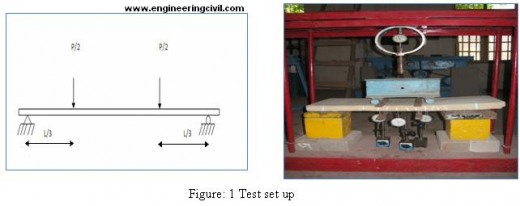Research Paper by
A.Dhasarathan1, Dr. R. Thenmozhi2, Mrs. S. Deepa Shree 3
1 PG Scholar, Government College of Technology, Coimbatore
2Associate Professor, Government College of Technology, Coimbatore
3 Assistant Professor, Jansons Institute of Technology, Coimbatore
ABSTRACT
Ferro cement elements are generally more ductile when compared to conventional reinforced concrete elements but post peak portion of load- deflection curve in bending test of Ferro cement elements reveals that failure occur either due to mortar failure in compression or due to failure of extreme layers of mesh. In this paper a study has been made on the ductility behaviour of hybrid Ferro cement elements by strengthening it in its tension zone by using GFRP layers and by adding polypropylene fibers into concrete. In present study, slab specimens of each 700 mm X 300 mm with varying parameters such as number of layers of mesh (2 & 3 bundled), layers of GFRP sheets (0 & 1) along with and without a specified proportion (0.30%) of polypropylene fibers were cast. Two point loading test was conducted on slabs and parameters such as ultimate moment capacity, ductility ratio and crack pattern were observed. From experimental results it was found that wrapping of GFRP in tension zone of slab increases confinement of bottom zone and using of fibre reinforced concrete has an influence on ductility and flexural capacities of ferrocement slabs.
Keywords: ferrocement slabs, GFRP wrapping, fibre reinforcement, ductility factors
INTRODUCTION
Ferro cement is a composite material made up of cement mortar and reinforcement in the form of layer of mesh. The mesh may be made of metallic or other suitable materials. Unlike conventional concrete, Ferro cement reinforcement can be assembled into its final desired shape and the mortar can be plastered directly in place without the use of a form which results in a flexible and strong enough ferrocement structures. Ferro cement is truly the first invention of reinforced concrete, the most used construction material in the world but the main difference between them is wires or meshes, and a concrete binder which, unlike cement paste and mortar, contains larger size aggregates. Ferrocement is a form of reinforced concrete that differs from conventional reinforced or prestressed concrete primarily by the manner in which the reinforcing elements are dispersed and arranged. It consists of closely spaced, multiple layers of mesh or fine rods completely embedded in cement mortar. A composite material is formed that behaves differently from conventional reinforced concrete in strength, deformation, and potential applications, and thus is classified as a separate and distinct material. It can be formed into thin panels or sections with only a thin mortar cover over the outermost layers of reinforcement.
From the structural point of view, the conventional reinforced concrete materials are much used for load carrying elements when compared to the ferro cement materials due to lack of elaborate investigation works on the ferrocement materials and its use as a structural elements. One such area to be investigated for ferrocement elements are its ductility characteristics. Ductility is the ability of a structural member to absorb energy is an important factor which affects the overall performance of structural elements. This paper discusses the load vs. deflection, moment curvature characteristics, displacement ductility and curvature ductility capacity of ferrocement slabs.
RESEARCH SIGNIFICANCE
Ferrocement elements are generally more ductile when compared to the conventional reinforced concrete elements due to the fact that, reinforcement is uniformly distributed over the entire section of the elements. But the post peak portion of the load- deflection curve of bending test of ferrocement elements reveals that the failure occur either due to mortar failure in compression or due to the failure of extreme layers of mesh [1]. So, an attempt has been made to study the ductility behaviour of ferrocement slabs by strengthening the slabs in its tension zone by means of external wrapping and by adding the synthetic fibers along with the ferrocement concrete materials. It was also found that the increase of volume fraction of wire mesh reinforcement as a bundled layer than that of evenly distributed reinforcements has an influence on the load carrying capacity and cracking behaviour of the ferrocement elements [10]. The purpose of this paper is to investigate the effect of number of wire mesh reinforcement, wrapping of gfrp layers on the tension side of slabs, and the effect of polypropylene fibres on the ferro cement slabs. This paper provides information regarding (i) Deformation characteristics such as Load Deflection, Moment Curvature, (ii) Ductility factors such as Displacement ductility and Curvature ductility of ferrocement slabs.
2.1 EXPERIMENTAL INVESTIGATION
2.1.1 Variable Parameters
The primary variables considered in the program included 1) number of welded square mesh reinforcements, 2 bundled and 3 bundled layers, 2) number of gfrp layer wrapping, 0 and 1 layers and 3) percentage of polypropylene fibres in concrete, 0 and 0.3% by volume of concrete.
2.1.2 Test specimens
A total of six series of each two specimens of ferrocement slabs were cast and are tested. All specimens have a dimension of 700mm X 300mm with a thickness of 25mm each. The thickness of slab were kept constant and the parameters such as number of layers of wire mesh reinforcement (2 and 3 layered bundled reinforcement), number of layers of gfrp wrapping (0 and 1 layer gfrp) and the concrete mix with and without the polypropylene fibres (0 and 0.30%) totally accounts for 12 specimens. The specimens were designated as S11, S21, SG31, SG41, SF51 and SF61. Table 1 shows the details of the varying parameters used in the Ferro cement slabs in the present investigation work. The supplementary specimens such as each three numbers of 100mm cubes with and without the polypropylene fibres were cast along with the Ferrocement slab specimens and are tested for its compressive strength. Table: 2 gives the characteristic compressive strength of the 100mm size cubes cast with and without the polypropylene fibres.
Table 1: Ferrocement slab details and varying parameters
| S.NO |
SLAB ID |
THICKNESS IN MM |
WIRE MESH |
GFRP LAYERS |
FIBER |
|
1 |
S11 |
25 |
2 |
0 |
0 |
|
2 |
S21 |
25 |
3 |
0 |
0 |
|
3 |
SG31 |
25 |
2 |
1 |
0 |
|
4 |
SG41 |
25 |
3 |
1 |
0 |
|
5 |
SF51 |
25 |
2 |
0 |
0.30% |
|
6 |
SF61 |
25 |
3 |
0 |
0.30% |
Table: 2 Characteristic compressive strength
|
S.NO |
CUBE ID |
FIBER CONTENT (%) |
COMPRESSIVE STRENGTH (N/mm2) |
AVERAGE COMPRESSIVE STRESS(N/mm2) |
|
1. |
C1 |
0 |
28.4 |
28.1 |
|
2. |
C2 |
0 |
27.9 |
|
|
3. |
C3 |
0 |
28.0 |
|
|
4. |
CF1 |
0.3 |
32.8 |
32.4 |
|
5. |
CF2 |
0.3 |
32 |
|
|
6. |
CF3 |
0.3 |
32.4 |
2.2 Materials
The slabs were cast using Self compacting micro concrete, which gets compacted due to its own weight without any external vibration. This concept is used for the construction of ferrocement slabs in order to overcome the problems and difficulties in the construction process. The use of SCC in the construction of ferro cement slabs facilitate the easy placing of concrete without the requirement of skilled labours, vibrators and improving the quality and speed of manufacturing ferrocement products. The ingredients used are Ordinary Portland Cement of grade 53, river sand and baby jelly which passes through 6mm sieve and retaining in 4.5mm sieve size are used for preparing the concrete mix. As per the” European Guidelines for Self Compacting Concrete”, self compacting micro concrete mix ratio based on trial mix method was found to be 1:1.2:0.8 with a W/C ratio of 0.4. The various chemical admixtures such as super plasticizer of 0.85% and viscosity modifying agent of 0.23% by weight of cement were used for the preparation of self compacting concrete mix. Table : 3 gives the quantity of materials used for casting the slab specimens.
Table : 3 Material quantity for concrete
|
Cement (kg) |
Fine aggregate (kg) |
Coarse aggregate (kg) |
Water (liters) |
Silica fumes (kg) |
Super plasticizer (in ml) |
Viscocity modifying agent (in ml) |
|
2.43 |
3.888 |
2.61 |
1.3 |
0.8125 |
27.5 |
7.5 |
2.3 Concreting procedure
As the plan dimensions of the slabs were 700mm x 300 mm, the size of the reinforcement were kept as 690 x 290 mm to ensure a minimum cover of 5mm on each sides of the reinforcement, when placed inside the mould. Weld mesh of 690mm x 290mm was cut and was straightened to a plane surface by pressing with fingers aided by the use of a steel hammer. The cement, fine aggregate and coarse aggregates are mixed thoroughly in dry condition. Silica fumes are used as a mineral admixture replacing cement by 25%. For addition of water, initially 75% of the mix water was added to dry mix and mixed thoroughly. The SP, VMA were added to remaining 25% of the water and added to the mix along with polypropylene fibres and then the mixing was carried out for about two to three minutes. The self compacting mix was then placed in the slab moulds without vibration ensuring a minimum clear cover of 5mm for the slab specimen. Finally the surfaces are being leveled to get a uniform surface finishes.
2.4 Curing and application of GFRP layers
The specimens cast were left in the moulds for a period of 24 hours. Specimens were demoulded from the mould carefully and immediately placed under water in a curing tank and were allowed to cure under water for a period of 28 days. After the period of 28 days, the ferrocement slabs were taken out of the curing tank, dried and the bottom surface of the slab is made rough using of wire brush. GP resin twice by weight of the GFRP sheets is being applied using the brush on the bottom surface of the slab and the sheets are pasted and are pressed along the edges of the slabs. GFRP wrapped slabs are being kept for a period of 7 days and are allowed to get dried before the testing of slabs.
2.5 Instrumentation and Loading Procedures
All the specimens were tested in a 25kN- loading frame, which is fixed over a strong floor. The beams were simply supported with an effective span of 600mm c/c. Two point loads were applied transversely at one third distances from support using a cross beam. Along with it, 25kN capacity proving ring was used for the load application. Dial gauges of sensitivity 0.01mm were used to measure the deflection of the beams. The dial gauges were kept at mid span of the beam and other two were kept at one third distances from supports. In addition to deflectometer, the curvature meter was fixed at a specific gauge distance so as to measure the top and bottom strains. The behaviour of the beams was keenly observed from the beginning till collapse. The propagation of initial cracks due to the increase of load was also recorded. The loading was continued till the verge of collapse. The test setup is shown in the Figure: 1
3. TEST RESULTS AND OBSERVATIONS
3.1 Load vs. Deflection curves
The set of load vs. mid span deflection curve for all the slab specimens were given in the Figure:2. Initially, as the load increases, the deflection also increases linearly up to a certain load, yield load and after that point the mid span deflection varies non linearly and reaches the maximum value. Beyond the ultimate load point, the deflection starts increasing appreciably with decrease in load. From the load vs. deflection curves its is evident that the ultimate load carrying capacity of gfrp wrapped 3 layered bundled reinforcement slab is comparatively higher than those of fibre reinforced and the conventional ferrocement slabs.
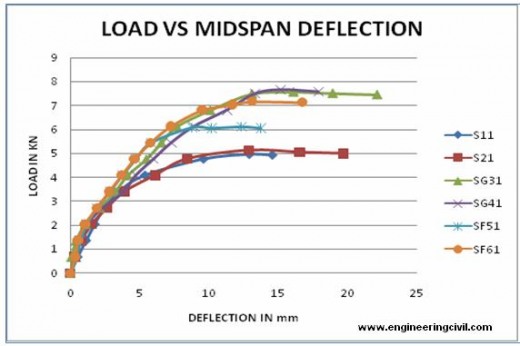
3.2 Moment Curvature Curves
The set of Moment curvature curves for the various ferrocement slab specimens were given in the figure: 3. The moment curvature curves of the specimens reveals that, even as the moment carrying capacity increases, the curvature for the gfrp wrapped slabs are relatively small in the initial stage of curve as when compared to that of conventional and the fibre reinforced slabs. This is due to the fact that, confinement in tension zone is being more provided by gfrp layer wrapping when compared to other slabs. The wider cracks were also observed for conventional and fibre reinforced slabs.
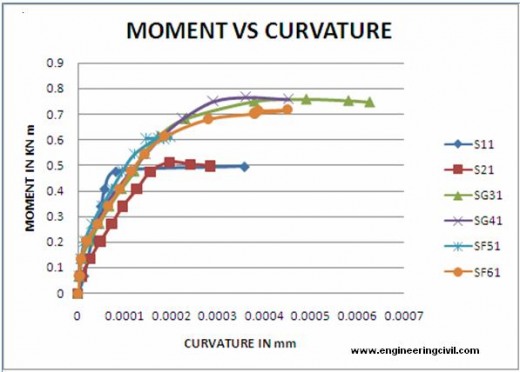
3.3 Cracking behavior
All the slabs exhibit a fairly ductile behaviour and the failure pattern is as shown in Figure: 5. The failure of slab specimens results from the yielding of wire mesh reinforcement followed by the crushing of concrete. Initially fine flexural cracks appeared at the bottom of the specimen, with further increase in the load, regularly spaced vertical cracks were observed and they extended from the bottom of the specimen towards the top fibre. The load was increased up to ultimate stage and cracking pattern is observed. Multiple cracking were observed in the fibre reinforced ferrocement slabs with number of micro cracks when compared to the other conventional and gfrp wrapped ferrocement slabs. The average crack width of fibre reinforced slabs were comparative low when compared to that of the other ferrocement slabs.
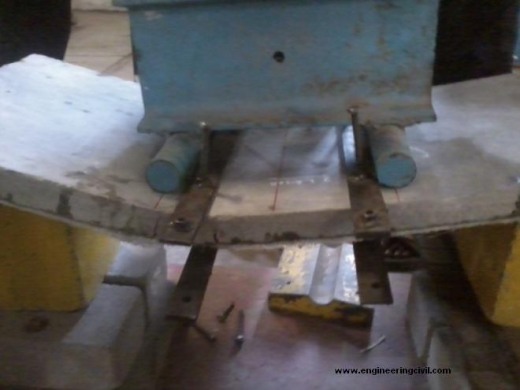
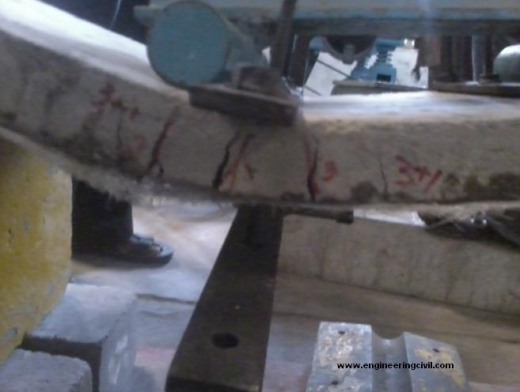
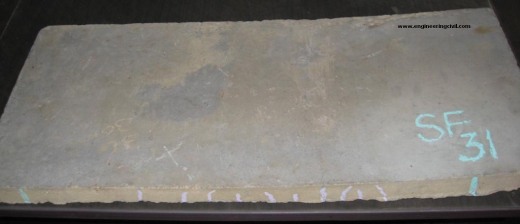
Figure: 5 Failure patterns of slab specimens
4. DUCTILITY PERFORMANCE
The ability of a member to deform without a significant loss of its strength is known as ductility. One method of quantifying ductility is by using the ductility factor (displacement ductility index and curvature ductility index) as defined by the ratio of ultimate deflection to the deflection at yielding of tensile reinforcement and the ratio of ultimate curvature to the curvature at yielding. Ductility Index, based on the failure state, where the failure load may be considered as equal to 85% of the ultimate load in the descending part of the load- deflection curve, is also of interest in some cases, especially in seismic design. The displacement and curvature ductility factors based on yielding of steel and ultimate stage are shown in Table: 4. it can be seen that displacement ductility factor varied from 8.8 to 13.8 and curvature ductility factor varied from 5.13 to 19.72 for ferrocement slabs. From the test results, the slabs without the gfrp wrapping and fibre reinforcement exhibits lower ductility ratios. The gfrp wrapped slabs with 3 bundled layered reinforcement exhibits a higher displacement ductility ratio and also curvature ductility ratios than those of fibre reinforced and conventional ferrocement slabs due to the fact that strengthening of tension zone on the slabs has better confinement which affect the ductility ratios. The provision of gfrp layers in the tension zone and also the reinforcing of polypropylene fibres in the concrete has better confinement capacity than the conventional ferrocement slabs preventing the disintegration of concrete in the compression zone even after the concrete reaches failure thereby improving failure ductility. The number of bundle ness of reinforcement of wire mesh also has effect on the ductility ratios due to increase in the volume fraction of reinforcements.
Table: 4 Experimental result values
|
S.NO |
SLAB ID |
YIELD LOAD IN KN |
ULTIMATE LOAD IN KN |
YIELD MOMENT IN KN m |
ULTIMATE MOMENT IN KN m |
DISPLACEMENT DUCTILITY |
CURVATURE DUCTILITY |
|
1 |
S11 |
1.75 |
4.95586 |
0.175 |
0.495586 |
8.835 |
14.262 |
|
2 |
S21 |
1.8 |
5.11924 |
0.18 |
0.511924 |
10.733 |
5.1282 |
|
3 |
SG31 |
2.3 |
7.56994 |
0.23 |
0.756994 |
11.485 |
15.334 |
|
4 |
SG41 |
2 |
7.65163 |
0.2 |
0.765163 |
13.809 |
19.719 |
|
5 |
SF51 |
2.1 |
6.09952 |
0.21 |
0.609952 |
10.283 |
13.684 |
| 6 |
SF61 |
2.2 |
7.16149 |
0.22 |
0.716149 |
13.08 |
19.109 |
5. CONCLUDING REMARKS
The tests on slabs carried out in this study describe the various possibility of improving the ductility characteristics of the ferrocement slabs. From the results of the experimental study reported herein, the following conclusions can be drawn.
A) The compressive strength of the polypropylene fibre reinforced concrete is about 15% higher than that of the conventional concrete specimens.
B) The increase in volume fraction of reinforcement that is number of layers of wire mesh reinforcement increases the load carrying capacity and ductility characteristics. Here, 3 layered bundled square wire mesh reinforcement slabs is having more load carrying capacity and good ductility characteristics compared to that of 2 layered wire mesh reinforcement slabs.
C) The gfrp wrapped ferrocement slabs shows the higher ductility ratio than that of the conventional ferrocement slabs due to the fact that, better confinement is being provided by the wrapping in the tension zone of the slabs. The wrapping acts as an external reinforcement and takes load in the tensile zone after the concrete fails.
D) The fibre reinforced ferrocement slabs also show a good load carrying capacity and ductility characteristics. In the tension zone, concrete matrix crack occurs as fibre starts acting. The fibre carries the load across the crack, transmitting the load from one sided of the matrix to other and as the fibre is randomly distributed, the cracks do not have very long paths, thereby loads bearing capacity of the whole matrix is increased and multiple cracking is observed.
Acknowledgements: The authors would like to express their gratitude to the Principal
Dr. R. Sundararajan and all the teaching and non-teaching staff members of Government College of Technology, Coimbatore, India for full co-operation to do this research work.
REFERENCES
1. Antoine E.Naaman, Ferrocement and Laminated Cementitious Composites, Techno Press 3000, 1st edition, USA, 2000.
2. Revathy .J, Suguna .K & Raghunath P.N, Strength and ductility of gfrp wrapped corrosion damaged concrete columns, International journal of applied engineering research, Vol-4, Issue:6, 2009.
3. Urmil V.Dave & Kinjal H. Trambadia, Behaviour of prestressed concrete beams using gfrp wrapping, 2009.
4. Dr. S. Rajamohan, M.C. Sundraraja, Strengthening of compression members with externally bonded composite fabrics- An experimental study, IE(I) journal, Vol-87, Feb 2007.
5. A. Sivakumar, Manu Santhanam, Mechanical properties of high strength concrete reinforced with metallic and non-metallic fibres, Cement and Concrete Composites, Volume 29, Issue 8, September 2007, Pg 603-608.
6. Gowdaman.N, Experimental studies on flexural strength of ferrocement slabs using self compacting micro concrete, M.E. thesis, 2009.
7. Ramkumaar.A, Experimental studies on ferrocement slabs using self compacting mortar, M.E. thesis, 2008.
8. A.W. Hago, K.S. Al-jabri, A.S. Alnuaimi, H. Al-moqbali, M.A. Al-kubaisy, Ultimate and service behavior of ferrocement roof slab panels, Construction and Building Materials, Vol-19 2005 ,Pages 31–37.
9. “The European Guidelines For Self Compacting Concrete” – EFNARC, MAY 2005.
10. “Specification and Guidelines for Self-Compacting Concrete” – EFNARC, February 2002.
11. ACI 549.1 R-93, “Guide for the Design, Construction, and Repair of Ferrocement” reapproved 1999.
12. P.Paramasivam and R.Sri Ravindrarajah, Effect of arrangement of reinforcements on mechanical properties of ferrocement, ACI Structural Journal, Jan- Feb 1988.
We are thankful to Sir A.Dhasarathan for publishing his research work here on engineeringcivil.com.We hope this research paper will help many civil engineers around the world in understanding the Ductile Characteristics Of Hybrid Ferrocement Slabs.
If you have a query, you can ask a question here.



